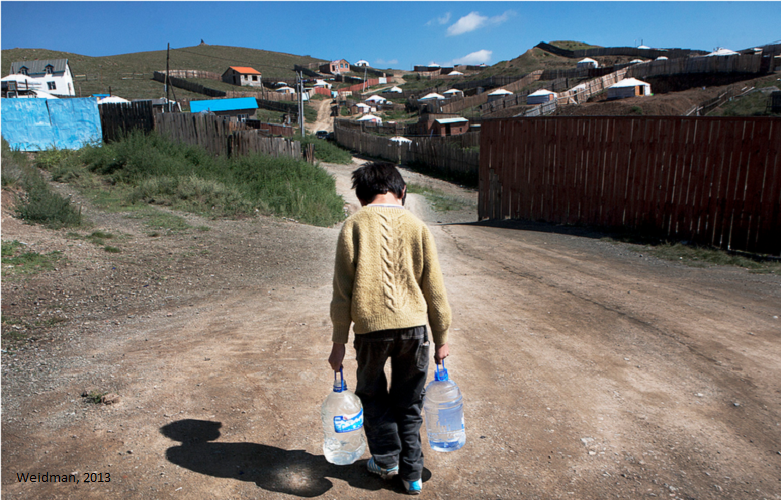 Source: Taylor Weidman, 2013
Source: Taylor Weidman, 2013Ulaanbaatar represents a population not responsible for climate change yet who must deal with its ramifications. After performing a climate risk assessment (Mehrotra et al., 2009) for Ulaanbaatar, evaluating the hazards, vulnerabilities and adaptive capacity of the city, we propose policies in response to the growing social, environmental, and economic pressures.
The city is extremely cold and temperature averages will only change marginally by 2100 (IPCC AR5, 2013; WMO, 2013). Precipitation data reflects a desert biosphere with current summer and winter averages and projections remaining near 20 cm and 2 cm, respectively (IPCC AR5, 2013; WMO, 2013).
In recent years storms, made worse and more frequent by climate change, have killed millions of livestock throughout the Mongolian countryside, driving herders to
Ulaanbaatar (Belt, 2011). This has increased the strain on resources, and created new social issues (e.g. a lack of adequate housing). Herders often end up living in informal settlements with inadequate access to enough water and sanitation services (Heckman, 2013). This has the potential to impact water quality in the city. Growing industry places further demands on water supply (UN–‐‑Water, 2013).
The Mongolian economy is projected to double in the next five years, potentially increasing the government’s already substantial capital expenditure budget (The World Bank, 2012). The budget is supported by a strong international commitment to supply monetary and technological assistance (UN–‐‑Habitat, 2012; Sovacool et al., 2011). The willingness to create adaptive measures is reflected by the 1995 Law on Water; however, it has received substantially less commitment than other capital expenditure projects. The government also plays a large role in water distribution to informal settlements by setting up kiosks (UN–‐‑Habitat, 2012).
Water supply and quality are crucial issues to address in Ulaanbaatar due to rising demand, shrinking water tables, and the relative inattention given to water issues.
The first proposed policy measure is to expand water reuse technologies for industries through a price increase for freshwater that’s used for agriculture, industries, services, or power production as well as incentives for gray-water reuse. This measure would increase the availability of potable water to be used for human needs as well as adequately price limited resources by including environmental.
The second proposed policy measure is to encourage rapid improvement of low-income housing while incorporating water efficiency and grey-water reuse into building codes through a common theme of developing ger districts. To achieve this goal we propose a commitment to funding the Ger Area Development Agency on a substantial and sustained basis in conjunction with expanding its mission to include strategies for jobs, education, and improving sustainable development practices. This would address developing inequality in income and resource use in Ulaanbaatar.
Focusing on measures to increase water supply through pricing industrial use to reflect total costs to the city will address water quality and depletion concerns. Concentrating resources on the development of ger districts in Ulaanbaatar will address informal housing, as well as future immigration.
References
Belt, Don. (2011). The Urban Clan of Genghis Khan: An influx of nomads has turned the Mongolian capital upside down. National Geographic. Retrieved from: http://ngm.nationalgeographic.com/2011/10/ulaanbaatar/belt–‐‑text rptregcta=reg_free_np&rptregcampaign=20130916_rw_membership_r5p_w#
Heckmann, Arnaud (2013). Technical Assistance Completion Report. The Asian Development Bank. Retrieved from: http://www.adb.org/sites/default/files/projdocs/2013/43361–‐‑012–‐‑mon–‐‑tcr.pdf
Intergovernmental Panel on Climate Change. (2013). Climate change 2013: The physical science basis.
Mehrotra, S., C.E. Natenzon, A. Omojola, R. Folorunsho, J. Gilbride & C. Rosenzweig. (2009). Framework for city climate risk assessment. Washington, DC: World Bank.
Sovacool, B., D’Argostino, A., & Bambawale, M. (2011). Gers gone wired: Lessons from the renewable energy and rural electricity access project (REAP) in Mongolia. Energy for Sustainable Development, 15(1), 32–‐‑49.
United Nations Human Settlements Programme [UN–‐‑HABITAT] (2012). Water Operators’ Partnerships in Asia: Case Study III. Retrieved from: http://www.gwopa.org/images/case_studies_3.0.pdf
The World Bank. Poverty Reduction and Economic Management, (2012). Mongolia budget note series: Highlights of the 2013 budget and the fiscal outlook. World Weather Information Service. World Meteorological Organization. (2013, December). Ulaanbaatar. Retrieved from; http://www.worldweather.org/119/c00229.htm